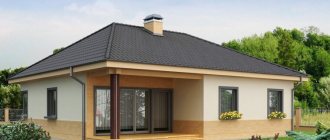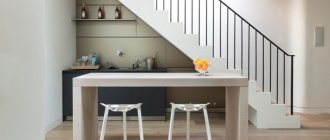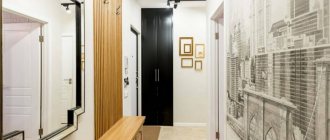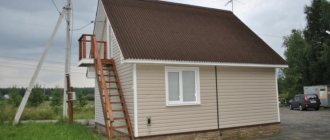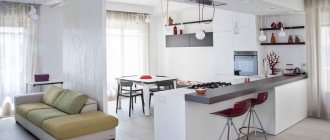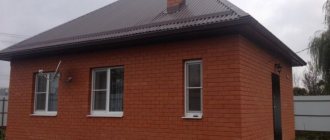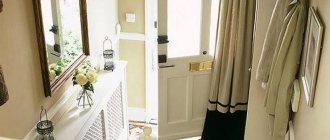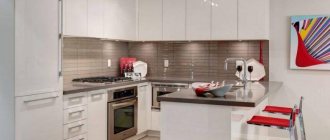Two-story houses are not only practical, but also beautiful. When choosing the method and materials for finishing the second floor, you should familiarize yourself with some advice from professional builders. The architecture of the attic can amaze the imagination with its non-standard and originality.
Before decorating the attic of a private house, you need to get acquainted with the features of facing work. Photos of the decoration of the second floor in a private house will help you choose a more suitable room design.
Preliminary work
During preliminary work, before finishing the attic, low walls are built along the edges of the room. At the same time, installing ceiling windows is a fairly practical solution.
The attic is a full-fledged living space, so for the comfort of living in it it is necessary to carry out insulation. Finishing will make the premises more comfortable. With a complete renovation and finishing of the attic space, the owners of the house receive additional living space.
During finishing work, it is important to adhere to the following principles:
- Stingrays must be protected as much as possible from wind and precipitation. It is necessary that they withstand serious temperature changes.
- Thermal insulation of the roof is carried out both indoors and outdoors. This increases the protection of premises from freezing and drafts.
- To insulate the attic, in addition to the insulation material, it is necessary to prepare sheets of plasterboard. Cement particle boards are suitable for finishing.
- The insulation pie includes a vapor barrier and a windproof layer.
Elements of the rafter system can become a decorative decoration for the attic space.
Construction of a frame house with a pitched roof
When choosing a frame house with a pitched roof, you need to add up all the pros and cons so that the choice is informed. In addition to the stylish design, you can get the following advantages:
- simplicity of design;
- low windage;
- saving on building materials (single roof - one-way drainage);
- high speed of roof installation;
- high reliability due to the absence of ridges, valleys and junctions.
The advantages are also followed by the negative aspects of such housing construction, namely:
- limited size of the structure - pitched roofs require a span of no more than 6 meters without additional supports;
- high snow load at low roof angles;
- due to the one-way drainage, there is an increase in the lockability of the foundation on one side of the house;
- impossibility of constructing an attic space.
When assessing the pros and cons, an important factor in the choice is the region of construction with its own characteristic weather conditions: amount of precipitation, strength and wind pattern.
Formation of a pitched roof
When building frame houses with a pitched roof, I follow all the rules for creating a roofing pie. The formation of the entire structure begins with the sheathing, which I install under the rafters laid on the front and rear walls of the building.
The second step is to lay a vapor barrier, which I install on top of the sheathing, bypassing the rafter beams with the vapor barrier.
I fill the entire space between the beams with insulation to the very top. It is better to use insulation based on stone wool.
On top of the insulation I attach a hydrobarrier film, on top of which I punch counter-lattice bars along the rafters. This is necessary to form a ventilation gap between the top sheathing and the hydraulic barrier.
Depending on the material of the finishing coating, I attach the top lathing with or without gaps.
By installing the finishing coating, I complete the formation of the pie roof of a frame house.
So, the roofing pie of a pitched roof looks like this:
- bottom sheathing;
- vapor barrier;
- insulation;
- hydrobarrier;
- counter-lattice;
- top sheathing;
- finishing coating.
Rafter system
Forming a pitched roof in a frame house is possible in two ways: due to the difference in the height of the opposite walls of the house (beam system) or using a triangular truss.
The beam system is limited in its application by the distance between the walls, which cannot be more than 6 m without additional supports. This is due to the load-bearing capacity of the floor beams and the length of the lumber, the measured length of which is exactly 6 meters. This design can be used in the construction of small buildings: garages, outbuildings.
When using such a design on buildings with spans greater than 6 meters, you need to be prepared to install additional supports (walls, columns), and the upper beams will have to be strengthened with jibs and supports. For large spans, it is also necessary to install rectangular trusses along the entire length of the building to ensure the load-bearing capacity of the upper beam.
A more acceptable option and one that I use in the construction of frame houses with a pitched roof is a triangular pitched truss. In this case, the truss can be manufactured at the factory or assembled directly on the site during the construction of the house.
The advantages of such a system are that by changing the angle of inclination of the structure, you can regulate the effect of snow load on the components of the house.
The elements of the truss, which can be assembled at enterprises for assembling wooden structures, are connected to each other by toothed plates.
Such designs are typical for American frames. And the technology of such fastenings was patented in America in the 50s of the last century. I would like to note that trusses connected in this way can provide strength to houses with a span length without supports of up to 12 meters.
Roof slope - how to form and why it is needed
The first task of the roof is to isolate the interior of the house from external factors (rain, snow). To avoid soaking and leaks, it is necessary to ensure guaranteed drainage of water from the roof surface during rain and melting snow. It is for this purpose that the roof surface is sloped
The windage of the entire structure depends on the slope of the roof. An angle that is too steep will ensure complete drainage of water and snow, but will make the roof vulnerable to gusts of wind. In addition, not all roofing materials can be used on steep roofs.
A shallow angle will expand the range of roofing carpet, but will increase the risk that water will stand on the roof after rain or when snow melts.
The angle of inclination of a pitched roof should be optimal. But still, the formation of one or another angle depends on the choice of roofing material and the region of construction with characteristic weather conditions and precipitation levels.
The formation of the angle of inclination with the beam system is carried out due to the walls of the house of different heights.
Using trusses, the angle of inclination of the roof is formed by the angle of installation of the upper chord. At the same time, taking into account that the truss with its elements is calculated by special computer programs, you can be sure that the angle of inclination in this case will be optimal. The weather, snow and wind loads will be taken into account.
Installation of a pitched roof (step-by-step scenario)
A pitched roof in a frame house, the installation of which is planned to be carried out, must be calculated by specialists. Firstly, it eliminates unnecessary waste of building material. Secondly, it allows you to be sure that the roof will withstand all the tests of nature (winds, rains and snowfalls).
So, I start the installation with a detailed calculation. This will give me the exact cross-section of the top beam, which can be 100*50 mm, 150*50 mm, 200*50 mm, 220*50 mm. Indicates points that need to install supports or slopes (with a beam system). It will show weak points in the timber, where it may be necessary to install a rectangular truss.
Option 1 - beam system
I begin the installation of the beam system after installing the walls and forming the ceiling of the upper floor. I make a breakdown along the upper and lower walls indicating the installation locations of the layered rafters (upper roof beam). I make the breakdown in increments of 600 mm.
Near the installation sites of the rafters, I install a perforated corner, through the holes of which I will fasten the rafters. First, I make nests in the lower part of the beams in those places where there will be contact with the upper frame of the wall. I assemble rafters over the entire roof area.
After installing the rafters, I begin installing the bottom sheathing, which I make from boards 25-30 mm thick. The board can be edged or unedged, but I make sure to clean it from any remaining bark. The sheathing can be attached with small gaps, taking into account that the space under the roof will be unusable.
I attach a vapor barrier film on top of the sheathing (on the outside of the roof). Installation is carried out from the bottom up with obligatory overlap and sealing of joints with tape. I secure the vapor barrier by wrapping the rafters on top.
I place insulation boards made of mineral wool or expanded polystyrene into the cavity between the rafters. Polystyrene foam cannot be used, as it is a flammable material.
I cover the insulation with a hydrobarrier. We fasten it with a stapler to the rafters, and then fix it along the top of the beams with a 2-3 cm thick slats. These slats act as a counter-lattice, forming a ventilation gap.
I mount the top batten along the top of the counter-lattice. Depending on the finishing material, I install it with an equal gap (under metal tiles or piece tiles) or with a free distance, so that later I can secure OSB sheets for the installation of flexible tiles or euroroofing felt.
I attach a finishing coating to the formed surface, the choice of which depends on the angle of the roof.
Option 2 – triangular truss system
In this option, installation is faster and more technologically advanced. The use of trusses in the case when a frame one-story house with a pitched roof is being built makes it possible to reduce the cross-section of the upper chord to dimensions of 50 * 40 mm.
Trusses are manufactured centrally at the factory in one size and delivered to the site in finished form.
Installation of such a system is carried out immediately after installation of the walls. A distinctive feature of this option is that the lower chord of the trusses can serve as beams to form the rough ceiling of the house.
I also begin the installation of structures after laying out the opposite walls with the same pitch - 600 mm. The first to install is the gable truss, which I fix directly to the wall using perforated corners installed on the supporting (for trusses) walls.
I install the second truss according to the markings and fasten it to the first, temporary beam along the upper chord.
I install and fasten the remaining structures in the same way.
After installing the roof frame, I cover the façade (high) gable, which allows me to fasten all the structures together.
From the inside of the building, along the lower belt of the trusses, I install a vapor barrier with overlapping strips and sealing the joints.
I pierce the sheathing along the entire plane of the ceiling with an edged board without gaps (solid).
In this option, I insulate the ceiling, and the entire space from the roof to the insulation remains cold, but well ventilated.
I lay insulation between the trusses so that the bottom chord, which is usually 100 mm high, is hidden.
I begin to lay the lathing on the upper belt of the trusses from the bottom up after installing the first strip of the hydraulic barrier. That is, in this option, the hydrobarrier film and the sheathing board are installed almost simultaneously.
Having completed the installation of the sheathing, I attach the finishing roofing covering.
Installation of lathing and counter-lattice
In the case of a pitched roof, the sheathing beats twice. And in both cases it has special functions. To form a full-fledged roofing pie, lower and upper lathing is used.
The lower lathing is mounted on the bottom of the layered rafters or on the lower chord of the trusses. Its main task is to retain the insulation.
With layered rafters, I begin installing the bottom sheathing from the bottom of the building. I fasten it with anodized screws. The entire area is covered with lathing at once. I fasten either completely or with gaps. You can use an unedged board, the sides of which are completely cleared of burrs.
If the roof is formed using trusses, then the lower sheathing is installed from the inside of the building. In this case, I use a trim board to make the fit as tight as possible.
There are times when I install trusses on a finished floor. Then the bottom sheathing is not installed at all.
Counter-lattice is a block with a size of 20*40 mm (30*40 mm), which is installed on the upper edge of the rafters or the upper chord of the trusses. Its purpose is to form a ventilation gap between the roofing and the waterproofing film. I fasten the block with nails 40 mm long.
The top sheathing is the basis of the roof covering. Its installation is carried out from bottom to top with a given step. For metal tiles, boards 100 mm wide and 30 mm thick are used. This size allows the sheet wave to rest securely on the sheathing. And if the step “walks” within 15 - 20 mm, the width of the board will not allow the fasteners to pass by. For piece tiles I use 40*40 mm timber.
If the top covering is rolled bituminous materials or flexible tiles, then a leveling layer of OSB boards is mounted on top of the sheathing of boards.
Selection of roofing material
Depending on the angle of inclination of the roof, the choice of material is made. For small slopes (from 5 to 10 degrees), materials are used that have the least number of open joints. This applies to rolled bitumen materials. The main one is built-up euroroofing felt, which is installed in two layers using the hot method with overlapping joints.
At angles close to steeply sloped roofs (which is about 30 degrees), ordinary slate, ceramic piece tiles, and metal tiles are used.
If the slope angle is in the range of 10 – 30 degrees, corrugated roofing sheets, bitumen shingles, metal tiles, and seam metal roofing can be used.
Installation of roofing and thermal insulation
Before completing the installation of the roof, I insulate it. The thermal insulation cake of the roof consists of three main elements:
- vapor barrier;
- insulation material;
- water protection.
A vapor barrier film, which can be dense polyethylene, is installed on the side of the room to prevent moisture from entering the heat insulator. Attaches directly to the mounted bottom sheathing.
Stone wool is used as insulation, but rolled material can also be used. This justifies the fact that the insulation on both sides is covered with lathing and no one will walk on it. Since the attic space cannot be built with a pitched roof, you can use expanded polystyrene sheets as insulation.
It closes the insulating structure - a hydrobarrier, which prevents moisture from entering from the outside, but removes the internal moisture of the insulation to the outside.
After the insulation cake is formed, the roofing covering is installed. Depending on its type, the appropriate sheathing is installed. The sheet material is attached to a plank sheathing with a gap. Rolled and bitumen on a continuous flooring made of OSB, plywood or cement-bonded particle boards.
Having completed the installation of the roofing, I install the junction strips, wind strips, and install the drainage system.
Floor finishing
To properly finish the floor of the second floor of a wooden house, you should create a layer of sound insulation inside the ceiling. For this purpose, you can use any soundproofing material. Insulation such as mineral wool copes with this task quite well. It is laid between the floor beams. Before laying the insulation on the beams, it is necessary to spread the film. You can lay mineral wool 5-10 cm thick. Expanded clay, as well as granulated penoizol, are excellent for insulation.
Advice! To soundproof walls during finishing, you should not choose foam plastic. It has a low level of sound absorption. At the same time, small rodents love it.
Finished floors are laid on top of the beams. When the beams are located less than 40 cm from each other, plywood sheets can be laid on them. If there is a large distance between the beams, boards are first mounted on them. They must have a thickness of at least 3.5 cm. The main condition is to maintain the shape of the boards when walking. The floor should not bend under the weight of a person’s body. Plywood sheets can then be laid on these boards.
Features of the layout of a two-story house: what to consider
Construction of a country cottage is a responsible task that not everyone is able to undertake. There are a large number of nuances, failure to comply with which will lead to unpleasant consequences. These little things are especially important for those who are planning to build a dream home with their own hands.
Layout of a two-story cottage Source Layout of a two-story cottage
Finish floor covering
A variety of materials can be used for finishing the floor in the attic. Their choice depends on the chosen style of the room and the characteristics of its use. Quite often, carpet, linoleum, and laminate are chosen to cover the floor in the attic. If you are installing a bathroom on the second floor, you will need to lay ceramic tiles.
To install parquet, you must first lay the underlay on the floor. This will ensure the necessary shock absorption and sound insulation of the floor. To lay the tiles, you will need to create a cement screed. It must be reinforced.
Number of inputs
Most modern country cottages have 2 doors: the front door, facing the façade of the house, and the back door, leading to the plot, garage, and adjoining gazebo. This amount makes life much easier, without forcing you to walk around several times every day. A beautiful door will be used to welcome guests, the second one will be used for household, everyday needs.
Straight staircase in the interior of the first floor Source leosguera.com
Interior finishing options
When creating living quarters in the attic, it is necessary not only to finish, but also to insulate the walls that are formed by the roof of the house. To do this, mineral wool or penoplex is installed between the rafter legs. On the roof side, the insulation is covered with a waterproofing layer, and on the room side - with a vapor barrier.
Before finishing, the rafter legs are covered with plywood. It is important to properly secure the vapor barrier film. To do this, you should carefully study the instructions for finishing the room using a vapor barrier.
As a result of this work, the roof slopes will be well insulated. Finishing of the attic can be carried out after the roof construction is completed. With this solution, the insulation material is hemmed from the side of the room. Gable walls are insulated in the same way.
Choosing a style for the second floor of a private house
Before moving on to renovating the second floor, you need to determine the design and style of the premises. It is important to pay attention to every detail, every little thing, because there should be nothing superfluous in the design of the rooms, and every decorative element should be in harmony with the room, emphasizing the refined taste of the homeowner. Only a thorough design and its high-quality implementation will help create a cozy atmosphere and housing that you won’t want to leave.
First, let's choose a style that will be taken as a basis when creating the interior design of the second floor. The following directions are currently popular:
- Provence is a romantic style from the southern coast of France, which has appealed to many homeowners in Russia. A cozy cottage decorated in this style is suitable for both young couples and families with children. For decoration and decoration, warm colors, pastel colors and natural materials (wood, brick, plaster) are used. The decor here is high-quality textiles with floral motifs and plant patterns. Particular attention is paid to furniture typical of France (artificially aged wooden furniture or real antiques).
- Country (rustic style) is a style that first appeared in America and was used to decorate a ranch. Natural wood also predominates here, creating a cozy and warm atmosphere. For decoration, wood is used not only for purchasing furniture, but also for finishing surfaces (parquet, wooden panels and lining).
- Chalet. Do you love mountains and dream of a charming and cozy house in Switzerland? Then this style will be the ideal solution, because ecological materials are used inside, and the decor is wooden ceiling beams and animal skins or faux fur.
- Minimalism is a modern style that is especially popular in Russia. If the homeowner does not like an abundance of decor and other “trash,” then this style suits him best, because it uses simple and laconic forms, calm colors and natural materials. In addition, this style will be an ideal solution for small spaces and a small private house, because the interior is bright and cozy, comfortable and practical.
- The Arabic style is an unusual, one might even say exotic, solution. Of course, decorating the second floor in this style is not only difficult, but also expensive. The direction has hundreds of rules, because although it seems chaotic, in fact everything here is well thought out to the smallest detail. For decoration, decor with a characteristic pattern and wall coverings are used, but depicting animals and people in this style is prohibited.
- English style is conservative and restrained, simple and laconic. It is not difficult to arrange rooms in this style; it is enough to use wooden panels and thick curtains, dark colors and high-quality furniture that can turn the second floor of a private house into the home of a well-known detective or an English prince. The English style will be an ideal solution for arranging a library or office; in addition, the implementation of the project will not take much time.
Finishing the attic with plasterboard
Plasterboard sheets have many advantages. When using this material, home owners are in the black. This is due to the ease of installation of the material, ease of processing, the possibility of insulating walls and wide scope for design solutions.
Thanks to the use of drywall, you can create niches, arches and columns. The technology for installing such material in the attic is quite simple. Simple alignment of walls and ceilings is another advantage of using plasterboard sheets.
Plasterboard slabs must be fastened to the frame using a screwdriver. Before finishing, the sheets are pre-cut into elements of the required dimensions. To obtain smooth edges, trim them with a plane. Drywall sheets must be firmly fixed with screws. The step between the fastening elements should be 20-25 cm. When finishing a door or window, fastening is also carried out along the perimeter of the opening. If the sheathing is single-layer, the screw must be screwed in 1 cm. For double sheathing, it should be mounted 3.5 cm.
Important! It is better to leave a gap of 5 mm between the edges of the plasterboard sheets during finishing. This is necessary to compensate for roof swings. Subsequently, they must be puttied and sealed with reinforcing tape.
As you can see, finishing the attic with plasterboard is quite simple. Numerous videos will help you understand the finishing technology in more detail. Further decoration of the room can be completely different. You can wallpaper or lay tiles on drywall.
Simple but tasteful
Pay attention to the photo of the house without a ceiling. Photographs will help you create the right impression. The walls are made of concrete. It was not for nothing that the architects chose it. Concrete is one of the most popular building materials, regardless of the passage of time. Eco-friendly, flexible and durable. In some places, the façade design resembles a grid.
Large windows allow natural light to flood into the rooms. The windows look harmonious and help place the right accents. A cozy terrace will help fill pleasant moments with family and friends.
Finishing walls and ceilings
Eurolining has gained wide popularity when finishing attics. The use of this material has not lost its relevance for many years. Eurolining is practical and durable, and also looks beautiful. Cladding attic rooms with wood is a rather interesting option.
Installation of this material will not be difficult. You just need to secure the boards with their ends facing each other. They are hemmed directly to the rafters. Eurolining is fixed directly to the walls. In this case, there is no need to create a frame.
When using wood when finishing the attic, the room can be decorated in different ways:
- To make the interior more impressive, you can paint the boards in dark tones mixed with light ones. This will highlight the decorative cladding in the interior of the room.
- When using a block house, the room can be successfully divided into different zones. Elements of the system that are visible can be selected in such a way that they contrast with the walls. Quite often, stain is used to color them.
- Wallpaper with silk-screen printing on the entire wall is suitable for such rooms. Such decoration should be framed with molding.
- Furniture made in an antique style looks quite impressive when decorating walls with this material.
Advice! If the interior lacks original solutions, it can be revived with the help of decorative stone. They should decorate a small section of the wall.
Interior
When designing the interior of the attic floor, you should take into account some characteristic geometric shapes of the premises. We are talking about the placement of stairs, the furnishings of the bathroom and toilet, kitchen, as well as the placement of doors. The free height of staircases in relation to sloping roof surfaces should be taken into account. There are no difficulties when the direction of the stairs is parallel to the slope of the roof or the stairs are placed along the middle axis of the building. Free height is usually not a problem, but the placement of possible parts and components of the roof structure should be taken into account.
The furnishings of the bathroom and toilet should be taken into account the sloping surfaces of the roof, limiting the full height.
Placing doors can be challenging not only because of determining the height of the doorway itself. Here it is also necessary to take into account the unhindered opening of the door, taking into account the sloping wall.
What could he be like?
Design: Proektor bureau
Design: Proektor bureau
Design: Mikhail and Nikolai Zhilin
Design: Mikhail and Nikolai Zhilin
How to decorate the hall?
If the area of the upper floor is large enough, with several rooms and bathrooms, usually a hall is organized between them - a small corridor with access to the stairs.
Design: Dmitry and Daria Grigoriev
Design: Dmitry and Daria Grigoriev
Since the hall serves as a buffer zone between rooms, it is important not to overload it with furniture and additional decor.
Design: Proektor bureau
Design: Proektor bureau
Design: Tatyana Mironova
Design: Tatyana Mironova
Design: Dmitry and Daria Grigoriev
Design: Dmitry and Daria Grigoriev

